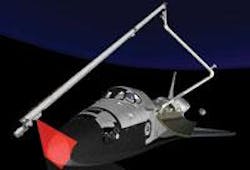Laser camera system inspects Discovery prior to reentry
A Laser Camera System (LCS) provided by Neptec (Ottawa, Ontario, Canada) played a vital role in the safe return of NASA’s Space Shuttle Discovery in August by providing detailed 3-D images of the spacecraft’s heat-shield tiles. The system can detect 0.5-mm cracks in the tiles from a distance of up to 4 m over the entire surface of the craft, thus enabling defects to be spotted prior to Shuttle reentry.
The camera was deployed at the tip of a 50-ft inspection boom, manufactured by MD Robotics (Brampton, Ontario, Canada), which was stored on the opposite side of the Shuttle’s cargo bay from the remote-manipulator system (called the Canadarm). To enable the LCS to scan the entire Shuttle surface, the Canadarm had to reach across the cargo bay and connect with the extension boom, nearly doubling the Canadarm’s reach (see figure). The LCS uses an autosynchronous triangulation technique to generate 3-D models of imaged objects that are accurate within a few millimeters and taken at distances up to 10 m. The scans transmitted back to Mission Control from the space shuttle could be zoomed and tilted while searching meticulously for damage.
The triangulation method is just as accurate and faster than generally more robust time-of-flight (TOF) imaging techniques at distances up to 5 m, according to Iain Christie, head of business development and R&D at Neptec. At distances from 5 to 10 m, triangulation maintains a speed advantage over TOF, but becomes less accurate. Triangulation sensors require a constant optical path length, however, so engineers at Neptec had to use a mirror system to essentially fold up the optical path to fit compactly into a single-box detection system.
Intelligent 3-D
Another engineering focus of the system was to provide a short feedback loop between the acquisition and processing of data. A general trend has been to gather large amounts of data and transmit them elsewhere for processing, which generates a tremendous need for bandwidth, according to Christie. “We want to break up that paradigm,” he notes. So the Neptec system focuses on achieving intelligent 3-D imaging by including significant data processing within the system. This enables decisions about what to scan and how to process the data to be made at the camera.
Moving-magnet galvanometers provided by General Scanning (Billerica, MA) moved the mirrors in the camera system for beam steering. Over and above designing the entire camera system into one compact box, Christie said the major engineering obstacle consisted in designing it to survive and operate through the temperature, vibration, vacuum, and other environmental extremes inherent in space travel. For instance, engineers at Neptec and General Scanning worked together to qualify an alternative dry lubricant that would enable the galvanometers to operate in the vacuum of space without the bearing lubricant outgassing and contaminating the mirror surfaces.
Simultaneous with the effort for the recent shuttle mission, Neptec was also developing a camera system for Lockheed Martin (Bethesda, MD) that combines triangulation and time-of-flight imaging and will enable imaging over distances ranging from hundreds of meters down to a few centimeters. The intent is to launch that system in 2007 on a NASA mission in which it will guide an autonomous rendezvous in space between the Hubble Space Telescope and an unmanned vehicle that will replenish Hubble’s power supplies, extending the telescope’s life by an additional five to seven years.
The technology that flew on the recent shuttle mission is already on the market, Christie says. “The cutting edge is already beyond that.”
About the Author
Hassaun A. Jones-Bey
Senior Editor and Freelance Writer
Hassaun A. Jones-Bey was a senior editor and then freelance writer for Laser Focus World.
